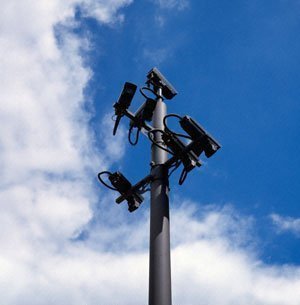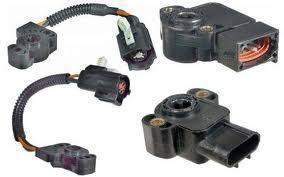There are several different types of traffic cameras. Some types of traffic cameras are only focused on traffic patterns and traffic density. Other types of traffic cameras are placed in locations where traffic infractions commonly occur to capture traffic incidents and record the details for punitive purposes.
Cameras for Traffic Monitoring
Cameras for traffic monitoring are placed in locations where there are complex intersections, traffic congestion, or locations with weather hazards. The cameras used for such purposes are digital and transmit low resolution pictures from a pole usually about 30 feet or more above the location.
Some of these cameras have Internet connectivity, and display their output for public review of traffic conditions. There are also websites where you can search for cameras in your area to check weather and other traveling considerations. A public front end for finding cameras in many geographic regions can be found here.
Although these cameras are not sophisticated enough to record the plates of a vehicle, other distinguishing characteristics such as model, make and color of the vehicle are easily identified.
How Do Red-Light Cameras Work?
Red-light cameras are used for identifying drivers who ignore traffic laws. Red-light cameras are activated when a driver passes through a certain point, usually located either in the middle of an intersection or at the end of the lane facing the red-light, when the traffic light is red. The red-light camera takes a snapshot of either the face of the driver or the license plate of the car. The camera then sends the picture to a computer system to find a match, and then automatically send a ticket to the driver’s address and alert the authorities.
Camera Placement
Red-light cameras can be placed in many different places and they can be so small that the driver does not even know that a camera is in the area. Red-light cameras can be inserted into the traffic light itself, placed on top or below the traffic light, or placed on another object so that the driver does not know he is being watched. For example, some red-light cameras are placed in bushes or on nearby buildings. Others are placed where drivers can see them, which should prevent drivers from breaking the law by passing through the red light.
Induction-Loop Trigger
An induction-loop trigger involves a number of rectangular loops placed under the asphalt at the stop line. An electric current is constantly passed through these loops which creates a magnetic field. When a massive metal object, such as a vehicle, passes over these loops during a red light, it affects the magnetic field of the induction loop. By doing so, the amount of electricity that is present in the induction loop is altered. On-board monitors inside of the traffic light system can detect this difference in electricity and trigger the red-light camera.
Video-Loop Trigger
A video-loop trigger involves using a camera placed on either the traffic light or a nearby object in order to record daily traffic. The camera forwards its constant, live recordings to a computer system that can check for the specific motion of a vehicle passing through an intersection. If a vehicle is passing through the intersection and the light is red, the computer will use the cameras to take a snapshot. Video-loop triggers are quickly replacing induction-loop triggers because they can be used without installing hardware beneath the road. Video-loop triggers are more convenient, cost-effective, and efficient at catching traffic violators.
Punitive Cameras
Punitive cameras are used by law enforcement agencies to automate part of the process used to ticket and fine motorists that are disregarding regulations and break the law.
These cameras are activated based on a special event, such as a motorist entering an intersection when the lights are red, or the vehicle is clocked at excessive speed by radar systems mounted near the camera system. The data is then transmitted to the law enforcement agency electronically for processing.




Aubrie
I got hit during a hit and run in a busy intersection. When i mentioned to the police officer, “at least there’s those cameras” and pointed to the ones above the red light, he looked down at his note pad, kinda smiled, then looked back at me, and said ” you would not believe what those cameras are for”. I should have had a follow up question for that comment, but was in too much shock, and was trying to process what it was he had just said to me. I hope that catch that m*#”)( f’er!
(it was the first vehicle I’ve ever bought, and I’m 15 weeks pregnant!)
ahmed
What are the components of the industry of waste grease and motor oil additives are used in the industry ???
Mike
How long do they store info ?